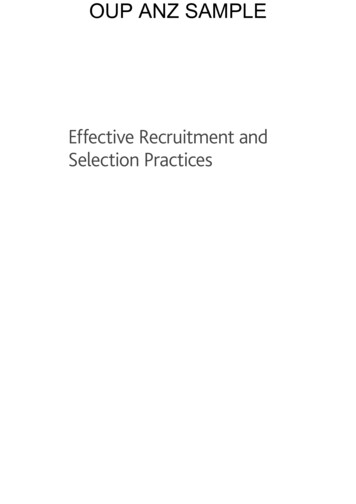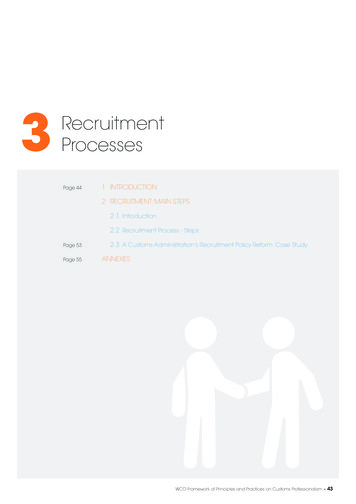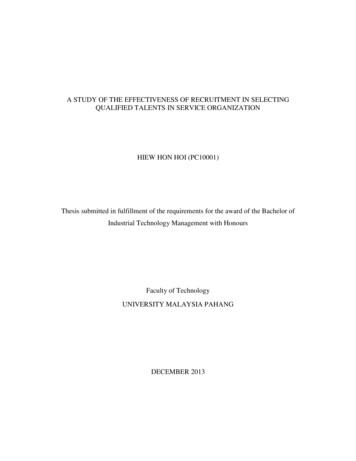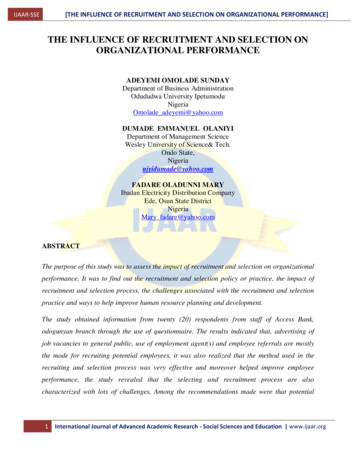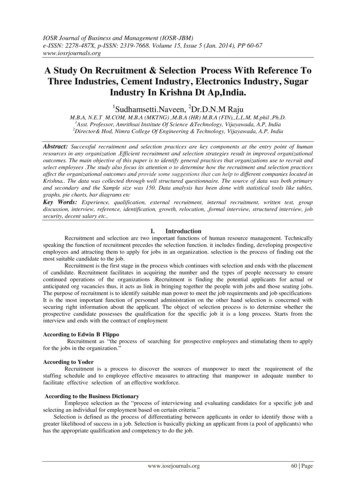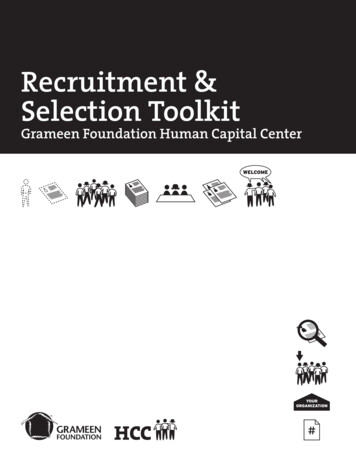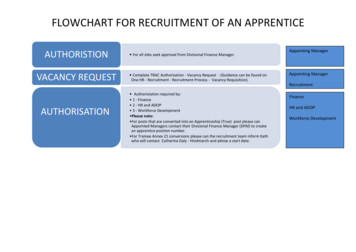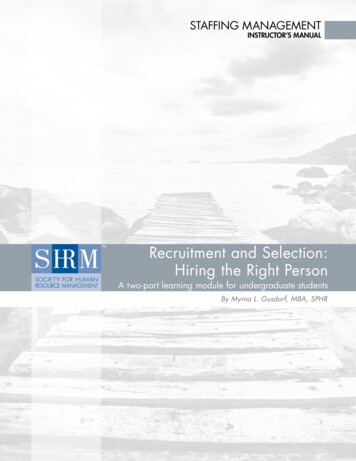
Transcription
Recruitment and SelectionAbout the TutorialRecruitment and Selection is an important operation in HRM, designed to maximizeemployee strength in order to meet the employer's strategic goals and objectives. It is aprocess of sourcing, screening, shortlisting and selecting the right candidates for therequired vacant positions.This is a brief introductory tutorial that explains different methods of hiring and how tomake effective and efficient utilization of Recruitment and Selection. In addition, it alsoexplains the best recruitment practices for specific requirements.AudienceThis tutorial will be useful for students from management streams who aspire to learn thebasics of Recruitment and Selection. Professionals, especially HR managers, regardless ofwhich sector or industry they belong to, can use this tutorial to learn how to apply themost effective type of Recruitment and Selection as per their specific requirement, in theirrespective project environments.PrerequisitesThe readers of this tutorial are expected to have a basic understanding of the complexityof Recruitment and Selection that an HR manager handles for hiring a right candidate fora required vacant position.Copyright & Disclaimer Copyright 2016 by Tutorials Point (I) Pvt. Ltd.All the content and graphics published in this e-book are the property of Tutorials Point (I)Pvt. Ltd. The user of this e-book is prohibited to reuse, retain, copy, distribute or republishany contents or a part of contents of this e-book in any manner without written consentof the publisher.We strive to update the contents of our website and tutorials as timely and as precisely aspossible, however, the contents may contain inaccuracies or errors. Tutorials Point (I) Pvt.Ltd. provides no guarantee regarding the accuracy, timeliness or completeness of ourwebsite or its contents including this tutorial. If you discover any errors on our website orin this tutorial, please notify us at contact@tutorialspoint.com.i
Recruitment and SelectionTable of ContentsAbout the Tutorial . iAudience . iPrerequisites . iCopyright & Disclaimer . iTable of Contents . ii1. Recruitment and Selection – Introduction . 1The Scope of Recruitment and Selection . 1Case Study: How to Improvise Recruitment Process. 22. What is Recruitment? . 53. Factors Affecting Recruitment . 7Internal Factors . 7External Factors. 84. Recruitment Process . 9Recruitment Planning . 9Recruitment Strategy . 12Searching the Right Candidates . 12Screening / Shortlisting . 14Evaluation and Control . 155. Types of Recruitment . 16Internal Sources of Recruitment . 16External Sources of Recruitment . 196. Recruitment Interviews . 22How to Interview? . 23Importance of Interview . 24Interview Process . 247. Types of Interviews . 268. What is Selection? . 28Importance of Selection . 29Advantages of Selection . 29Selection Process and Steps . 309. Salary Negotiations . 3110. Making a Job Offer . 33How to Make a Job Offer? . 33Preparing a Job Offer Letter . 34What Next after Issuing a Job Offer? . 35ii
1. Recruitment and Selection – IntroductionRecruitment and SelectionRecruitment and Selection is an important operation in HRM, designed to maximize employeestrength in order to meet the employer's strategic goals and objectives. In short, Recruitmentand Selection is the process of sourcing, screening, shortlisting and selecting the right candidatesfor the filling the required vacant positions.In this tutorial, we will discuss the various aspects of Recruitment and Selection such as therecruitment process, the factors affecting recruitment, recruitment planning, methods ofrecruitment, recruitment interviews, selection process and making an offer.The Scope of Recruitment and SelectionThe scope of Recruitment and Selection is very wide and it consists of a variety of operations.Resources are considered as most important asset to any organization. Hence, hiring rightresources is the most important aspect of Recruitment. Every company has its own pattern ofrecruitment as per their recruitment policies and procedures.The scope of Recruitment and Selection includes the following operations: Dealing with the excess or shortage of resources Preparing the Recruitment policy for different categories of employees Analyzing the recruitment policies, processes, and procedures of the organization Identifying the areas, where there could be a scope of improvement Streamlining the hiring process with suitable recommendations Choosing the best suitable process of recruitment for effective hiring of resources1
Recruitment and SelectionAny organization wants it future to be in good and safe hands. Hence, hiring the right resourceis a very important task for any organization.Case Study: How to Improvise Recruitment ProcessLet’s assume there is a company called ABC Systems, which sells FMCG products. The companyis lately suffering due to its high attrition rates. In this case study, we will see how ABC Systemscan improve its recruiting process and focus on maintaining the efforts required for filling a jobvacancy. We will also learn how the HR team of ABC Systems can reduce the time and effortinvolved in sourcing good resources for the vacant positions.We suggest here seven different steps that ABC Systems can utilize to resolve its problems.Step 1: Define the ProblemFirst, define the problem in exact terms and then, design a step-wise recruitment process thatcan be easily followed.Recruitment ProcessStep1ActivitySending the resignation communication message to HR with request for initiatingthe recruitment process2Manager-HR directs the hiring team to start the recruitment process3Logging into the employment website and contacting different recruiters4Sourcing, identifying, and collecting the resumes of the candidates5Receiving relevant resumes6Shortlisting the resumes8Sending the shortlisted resumes to the department manager9Schedule interview dates10Calling the candidates for interview12Interviewers complete the feedback form and the feedback is shared with the HR13This process repeats for many candidates till the best candidates are finalized.14The HR team negotiates the package and compensation15Final confirmation and agreements17Send offer letter18Offer acceptedStep 2: Research the CausesAnalyze the root cause of the problem at hand. Why the attrition rate is so high? There areseveral ways to arrive at the root cause behind a problem.In case of ABC Systems, it was observed that there is only a less percent of candidates who arerejected in the process of review. Hence, there is a need to improve this process by increasingthe number of rejections with an efficient review process.2
Recruitment and SelectionScreening of resumes must be very effective, because the selection of the candidates throughresume screening has maximum percentage of a positive outcome, which is explained below:Resume Selection TestReviewerResumes ProvidedResumes SelectedSuccessful Selections*110842105231072Reviewers can use a set of defined criteria to screen the resumes, which can then be compiledas shown below.Tabulation of Selection Criteria UsedCriteriaReviewer 1Reviewer 2Reviewer 31XXX2XXX3X4X5XX6XXX78XXXXXXStep 3: Countermeasure Ideas GenerationIt is mandatory to have a basis of standardization in selecting the candidates. The shortlistingof the relevant criteria is done as shown in the following table:Selection Criteria – StandardizedCriteriaReviewer 11X2X3XX4XX5XX6XX78XReviewer 2Reviewer 3Criteria to KeepXXXXXXXXXXXXXThe shortlisted list of candidates is reviewed by the department heads and they can suggestmodification which can then be incorporated as new criteria.3
Recruitment and SelectionStep 4: Testing and Modifying the IdeasThe next step is to test the defined set of criteria with three batches. After the selections aredone, the set of criteria is analyzed to see it was effective or not.Step 5: Implementing the IdeasIf found effective, then implement the new set of criteria for future recruitments.Step 6: Standardize ProceduresThe next step is to standardize the procedure. First, make a note of the improvements achievedrecruitment efficiency. It can done as shown in the following tables:Improvements in Recruitment views170142Improvements in Recruitment EfficiencyBeforeAfterPercentage ImprovementR/C6.254.134I/C10640With the help of the above processes, there will be a reduction of about 30%-40% in the hiringprocess in shortlisting, reviewing and selecting the candidates for the right job positions. Thisprocess was standardized and adopted in the regular practice.Step 7: Compiling the Quality Improvement StoryAt last, the improvised and the quality story is compiled and presented to the senior managementfor a better recruitment process.4
2. What is Recruitment?Recruitment and SelectionRecruitment is a process of identifying, screening, shortlisting and hiring potential resource forfilling up the vacant positions in an organization. It is a core function of Human ResourceManagement.Recruitment is the process of choosing the right person for the right position and at the righttime. Recruitment also refers to the process of attracting, selecting, and appointing potentialcandidates to meet the organization’s resource requirements.The hiring of the candidates can be done internally i.e., within the organization, or fromexternal sources. And the process should be performed within a time constraint and it shouldbe cost effective.Importance of RecruitmentRecruitment is one of the most fundamental activities of the HR team. If the recruitment processis efficient, then – The organization gets happier and more productive employees Attrition rate reduces. It builds a good workplace environment with good employee relationships. It results in overall growth of the organization.5
Recruitment and SelectionHere is a list that shows the purpose and importance of Recruitment in an organization: It determines the current and future job requirement. It increases the pool of job at the minimal cost. It helps in increasing the success rate of selecting the right candidates. It helps in reducing the probability of short term employments. It meets the organization’s social and legal obligations with regards to the work force. It helps in identifying the job applicants and selecting the appropriate resources. It helps in increasing organizational effectives for a short and long term. It helps in evaluating the effectiveness of the various recruitment techniques. It attracts and encourages the applicants to apply for the vacancies in an organization. It determines the present futures requirements of the organization and plan according. It links the potential employees with the employers. It helps in increasing the success ratio of the selection process of prospective candidates. It helps in creating a talent pool of prospective candidates, which enables in selecting theright candidates for the right job as per the organizational needs.6
3. Factors Affecting RecruitmentRecruitment and SelectionRecruitment is an important function of the Human Resource Management in an organization,and it is governed by a mixture of various factors. Proactive HR Professionals should understandthese factors influencing the recruitment and take necessary actions for the betterment of theorganization.When the market condition changes, the organization also needs to monitor these changes anddiscover how it affects the resources and analyze these functions for making recruitment aneffective process.We have Internal Factors as well as External Factors that influence the recruitment process.In this chapter, we will be discussing these factors in detail.Internal FactorsOrganizations have control over the internal factors that affect their recruitment functions. Theinternal factors are: Size of organization Recruiting policy Image of organization Image of jobSize of OrganizationThe size of the organization is one of the most important factors affecting the recruitmentprocess. To expand the business, recruitment planning is mandatory for hiring more resources,which will be handling the future operations.Recruiting PolicyRecruitment policy of an organization, i.e., hiring from internal or external sources oforganization is also a factor, which affects the recruitment process. It specifies the objectives ofthe recruitment and provides a framework for the implementation of recruitment programs.Image of OrganizationOrganizations having a good positive image in the market can easily attract competentresources. Maintaining good public relations, providing public services, etc., definitely helps anorganization in enhancing its reputation in the market, and thereby attract the best possibleresources.Image of JobJust like the image of organization, the image of a job plays a critical role in recruitment. Jobshaving a positive image in terms of better remuneration, promotions, recognition, good workenvironment with career development opportunities are considered to be the characteristics toattract qualified candidates.7
Recruitment and SelectionExternal FactorsExternal factors are those that cannot be controlled by an organization. The external factors thataffect the recruitment process include the following: Demographic factors – Demographic factors are related to the attributes of potentialemployees such as their age, religion, literacy level, gender, occupation, economic status,etc. Labor market – Labor market controls the demand and supply of labor. For example, ifthe supply of people having a specific skill is less than the demand, then the hiring willneed more efforts. On the other hand, if the demand is less than the supply, the hiringwill be relative easier. Unemployment rate – If the unemployment rate is high in a specific area, hiring ofresources will be simple and easier, as the number of applicants is very high. In contrast,if the unemployment rate is low, then recruiting tends to be very difficult due to lessnumber of resources. Labor laws – Labor laws reflect the social and political environment of a market, whichare created by the central and state governments. These laws dictate the compensation,working environment, safety and health regulations, etc., for different types ofemployments. As the government changes, the laws too change. Legal considerations – Job reservations for different castes such as STs, SCs, OBCsare best examples of legal considerations. These considerations, passed by government,will have a positive or negative impact on the recruitment policies of the organizations. Competitors – When organizations in the same industry are competing for the bestqualified resources, there is a need to analyze the competition and offer the resourcespackages that are best in terms of industry standards.8
4. Recruitment ProcessRecruitment and SelectionRecruitment is a process of finding and attracting the potential resources for filling up the vacantpositions in an organization. It sources the candidates with the abilities and attitude, which arerequired for achieving the objectives of an organization.Recruitment process is a process of identifying the jobs vacancy, analyzing the job requirements,reviewing applications, screening, shortlisting and selecting the right candidate.To increase the efficiency of hiring, it is recommended that the HR team of an organizationfollows the five best practices (as shown in the following image). These five practices ensuresuccessful recruitment without any interruptions. In addition, these practices also ensureconsistency and compliance in the recruitment process.Recruitment process is the first step in creating a powerful resource base. The process undergoesa systematic procedure starting from sourcing the resources to arranging and conductinginterviews and finally selecting the right candidates.Recruitment PlanningRecruitment planning is the first step of the recruitment process, where the vacant positions areanalyzed and described. It includes job specifications and its nature, experience, qualificationsand skills required for the job, etc.A structured recruitment plan is mandatory to attract potential candidates from a pool ofcandidates. The potential candidates should be qualified, experienced with a capability to takethe responsibilities required to achieve the objectives of the organization.9
Recruitment and SelectionIdentifying VacancyThe first and foremost process of recruitment plan is identifying the vacancy. This process beginswith receiving the requisition for recruitments from different department of the organization tothe HR Department, which contains: Number of posts to be filled Number of positions Duties and responsibilities to be performed Qualification and experience requiredWhen a vacancy is identified, it the responsibility of the sourcing manager to ascertain whetherthe position is required or not, permanent or temporary, full-time or part-time, etc. Theseparameters should be evaluated before commencing recruitment. Proper identifying, planningand evaluating leads to hiring of the right resource for the team and the organization.Job AnalysisJob analysis is a process of identifying, analyzing, and determining the duties, responsibilities,skills, abilities, and work environment of a specific job. These factors help in identifying what ajob demands and what an employee must possess in performing a job productively.Job analysis helps in understanding what tasks are important and how to perform them. Itspurpose is to establish and document the job relatedness of employment procedures such asselection, training, compensation, and performance appraisal.The following steps are important in analyzing a job: Recording and collecting job information Accuracy in checking the job information Generating job description based on the information Determining the skills, knowledge and skills, which are required for the jobThe immediate products of job analysis are job descriptions and job specifications.10
Recruitment and SelectionJob DescriptionJob description is an important document, which is descriptive in nature and contains the finalstatement of the job analysis. This description is very important for a successful recruitmentprocess.Job description provides information about the scope of job roles, responsibilities and thepositioning of the job in the organization. And this data gives the employer and the organizationa clear idea of what an employee must do to meet the requirement of his job responsibilities.Job description is generated for fulfilling the following processes: Classification and ranking of jobs Placing and orientation of new resources Promotions and transfers Describing the career path Future development of work standardsA job description provides information on the following elements: Job Title / Job Identification / Organization Position Job Location Summary of Job Job Duties Machines, Materials and Equipment Process of Supervision Working Conditions Health HazardsJob SpecificationJob specification focuses on the specifications of the candidate, whom the HR team is going tohire. The first step in job specification is preparing the list of all jobs in the organization and itslocations. The second step is to generate the information of each job.This information about each job in an organization is as follows: Physical specifications Mental specifications Physical features Emotional specifications Behavioral specificationsA job specification document provides information on the following elements: Qualification Experiences Training and development11
Recruitment and Selection Skills requirements Work responsibilities Emotional characteristics Planning of careerJob EvaluationJob evaluation is a comparative process of analyzing, assessing, and determining the relativevalue/worth of a job in relation to the other jobs in an organization.The main objective of job evaluation is to analyze and determine which job commands how muchpay. There are several methods such as job grading, job classifications, job ranking, etc.,which are involved in job evaluation. Job evaluation forms the basis for salary and wagenegotiations.Recruitment StrategyRecruitment strategy is the second step of the recruitment process, where a strategy is preparedfor hiring the resources. After completing the preparation of job descriptions and jobspecifications, the next step is to decide which strategy to adopt for recruiting the potentialcandidates for the organization.While preparing a recruitment strategy, the HR team considers the following points: Make or buy employees Types of recruitment Geographical area Recruitment sourcesThe development of a recruitment strategy is a long process, but having a right strategy ismandatory to attract the right candidates. The steps involved in developing a recruitmentstrategy include: Setting up a board team Analyzing HR strategy Collection of available data Analyzing the collected data Setting the recruitment strategySearching the Right CandidatesSearching is the process of recruitment where the resources are sourced depending upon therequirement of the job. After the recruitment strategy is done, the searching of candidates willbe initialized. This process consists of two steps: Source activation: Once the line manager verifies and permits the existence of thevacancy, the search for candidates starts.12
Recruitment and Selection Selling: Here, the organization selects the media through which the communication ofvacancies reaches the prospective candidates.Searching involves attracting the job seekers to the vacancies. The sources are broadly dividedinto two categories: Internal Sources and External Sources.Internal SourcesInternal sources of recruitment refer to hiring employees within the organization through: Promotions Transfers Former Employees Internal Advertisements (Job Posting) Employee Referrals Previous ApplicantsExternal SourcesExternal sources of recruitment refer to hiring employees outside the organization through: Direct Recruitment Employment Exchanges Employment Agencies Advertisements Professional Associations Campus Recruitment Word of Mouth13
Recruitment and SelectionScreening / ShortlistingScreening starts after completion of the process of sourcing the candidates. Screening is theprocess of filtering the applications of the candidates for further selection process.Screening is an integral part of recruitment process that helps in removing unqualified orirrelevant candidates, which were received through sourcing. The screening process ofrecruitment consists of three steps:Reviewing of Resumes and Cover LettersReviewing is the first step of screening candidates. In this process, the resumes of the candidatesare reviewed and checked for the candidates’ education, work experience, and overallbackground matching the requirement of the job.While reviewing the resumes, an HR executive must keep the following points in mind, to ensurebetter screening of the potential candidates: Reason for change of job Longevity with each organization Long gaps in employment Job-hopping Lack of career progressionConducting Telephonic or Video InterviewConducting telephonic or video interviews is the second step of screening candidates. In thisprocess, after the resumes are screened, the candidates are contacted through phone or videoby the hiring manager. This screening process has two outcomes: It helps in verifying the candidates, whether they are active and available. It also helps in giving a quick insight about the candidate’s attitude, ability to answerinterview questions, and communication skills.Identifying the top candidatesIdentifying the top candidates is the final step of screening the resumes/candidates. In thisprocess, the cream/top layer of resumes are shortlisted, which makes it easy for the hiringmanager to take a decision. This process has the following three outcomes: Shortlisting 5 to 10 resumes for review by the hiring managers Providing insights and recommendations to the hiring manager Helps the hiring managers to take a decision in hiring the right candidate14
Recruitment and SelectionEvaluation and ControlEvaluation and control is the last stage in the process of recruitment. In this process, theeffectiveness and the validity of the process and methods are assessed. Recruitment is a costlyprocess, hence it is important that the performance of the recruitment process is thoroughlyevaluated.The costs incurred in the recruitment process are to be evaluated and controlled effectively.These include the following: Salaries to the Recruiters Advertisements cost and other costs incurred in recruitment methods, i.e., agency fees. Administrative expenses and Recruitment overheads Overtime and Outstanding costs, while the vacancies remain unfilled Cost incurred in recruiting suitable candidates for the final selection process Time spent by the Management and the Professionals in preparing job description, jobspecifications, and conducting interviews.Finally, the question that is to be asked is, whether the recruitment methods used are valid ornot? And whether the recruitment process itself is effective or not? Statistical information on thecosts incurred for the process of recruitment should be effective.15
5. Types of RecruitmentRecruitment and SelectionFor any organization, recruitment is a crucial part of developing and maintaining an effectiveand efficient team. A good recruitment strategy will cut down the wastage of time and money,which would have incurred for extensive training and development of unqualified resources.Have you ever thought of, how a recruiter finds the right candidates? Recruiters use differentmethods to source, screen, shortlist, and select the resources as per the requirements of theorganization. Recruitment types explain the means by which an organization reaches potentialjob seekers.In this chapter, we will shed some light on the secrets of h
Recruitment and Selection 1 Recruitment and Selection is an important operation in HRM, designed to maximize employee strength in order to meet the employer's strategic goals and objectives. In short, Recruitment and Selection is the process of sourcing, s
